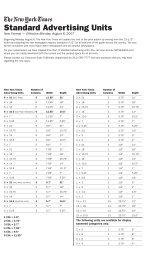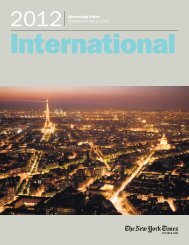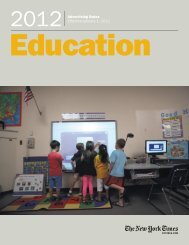CASE STUDYWEBER STATE UNIVERSITY COMMUNICATION DEPARTMENTCommunicating Common Ground:<strong>Civic</strong> <strong>Engagement</strong> Through Service-Learning in Interpersonal andSmall-Group Communication: A Partnership with Children-at-RiskAfter-School ProgramsColleen Garside, Ph.D., Assistant ProfessorIn Weber State’s Communicating Common Ground program,“college students...lead younger students in learning activities designedto advance multicultural education, appreciation of diversity,and the creation of communities in which hate, hate speech,and hate crimes are not tolerated” (Morreale, 2003, p. 3). CCG isa partnership between Communication 2110, Interpersonal andSmall Group Communication students and the Ogden-WeberSchool District Children at Risk Extended School (CARES)program. Communicating Common Ground (CCG) is a servicelearninginitiative sponsored by the National CommunicationAssociation, the Southern Poverty Law Center, Campus Compact,and the American Association <strong>for</strong> Higher Education. TheCCG partnerships focus on teaching tolerance and combatingprejudice in communities. Many first-year students enroll in thecommunication course to meet general education requirements.Communication 2110 students volunteer more than 1,500 hoursto the CARES program each year. University faculty, communitypartners, and CCG cooperate to facilitate the project, which hasbeen on campus <strong>for</strong> five years.Project Objectives and ImpactThe two objectives are integrated by the diversity of the programparticipants and by diversity training that educates students torespect and embrace diversity in society. Many Weber State studentshave had little, if any, contact with ethnicities not their own.Many CARES participants are Hispanic, which exposes studentsto different cultures. University students provide instruction topromote the recognition of prejudice, stereotyping, and culturalcommunication differences. Working in groups of four throughoutthe semester, they plan activities, strategies, and materials <strong>for</strong>instruction in communication and diversity issues to elementaryand secondary students involved in the CARES program. Theirfresh perspectives and innovations supplement the ef<strong>for</strong>ts ofCARES personnel. Weber State students find that they rein<strong>for</strong>cetheir own learning by presenting to CARES participantsUniversity students have reflected on the impact of their civicengagement experience in light of their learning. In reflectionessays, one group of students explained that “the students weworked with taught us as much as we taught them. This was veryworthwhile because we were not just wasting our time sitting ina classroom lecture. We actually had to go and apply the thingswe were learning.” Another group reflected: “This experience wasworthwhile because it challenged us to get out of our com<strong>for</strong>tzones. We discovered that interacting with other cultures is notdangerous or difficult. It is often enlightening.” Marsha Prantill,Coordinator <strong>for</strong> Ogden-Weber After School Programs, indicatesthat the ef<strong>for</strong>ts of the university students are appreciatedthroughout the district. “The (CARES) sites appreciate all thework and time these (university) students spend to enhance theeducational experience <strong>for</strong> our students.” The program has beenrecognized by the Utah Campus Compact as one of the top 13outstanding civic engagement projects in the state.AssessmentOverall, our assessment is consistent with other service-learningliterature that suggests that civic engagement through servicelearningfacilitates an enriched understanding of course material,provides meaningful service to the community and rein<strong>for</strong>cesmoral and civic values in students (Droge & Ortega-Murphy,1999; Gray, Ondaatje, Fricker,& Geschwind, 2000; Isaacson,Dorries, & Brown, 2001).Current assessment focuses on student perceptions of howcivic engagement influences affective, behavioral, and cognitivedomains of learning through a series of reflection assignmentsbased on Dewey’s [1938] notion of reflective thinking (see Eyler,Giles, & Schmiede, 1996; Welch, 2002). Over the semester, studentssubmit eight reflection papers and participate in oral in-classreflection. A thematic content analysis of 516 reflection paperssubmitted during an academic year provided data <strong>for</strong> analysis.Detailed data analysis led to categorization of emergent, recurrentthemes. The most prevalent theme that emerged was the trans<strong>for</strong>mativenature of civic engagement in affective, behavioral, andcognitive domains of learning.In the affective domain, students’ feelings about civic engagementwere trans<strong>for</strong>med. Trepidation and worry changed to interestand confidence. One student wrote, “I felt com<strong>for</strong>table at a verydiverse school, and I didn’t think I would at first. The first day, Iwanted to turn around and go home because I was so scared andworried. I learned to be com<strong>for</strong>table around the different personalitiesthat went to that school.”
Behavioral assessment predicted students’ future actions. Samplecomments: “I have enjoyed the CARES program so much, I willprobably volunteer again.” “As we taught the students, we learnedmuch more about how to communicate. We will try to show moresensitivity to people who are different from us.” “We as communitymembers need to be sensitive to the differences in others andtheir different upbringings.”Students also practiced critical thinking, analysis and application,as these comments show: “Recognizing ethnocentrism is justthe beginning. Collaboration is required to reconcile the differencesin culture and language to produce understanding betweenpeople. One girl tried to teach [a student] some words in Spanish.Most often the kids would just speak English, but in an ideal situation,we would all be working together <strong>for</strong> competent communication.We have learned that cultural relativism is better thanethnocentrism. We can acknowledge the fact that some culturesare different from - not better than - other cultures.”Work Cited:Dewey, J. (1938). Experience and education. New York: CollierBooks.I. Contributor’s Name and Contact In<strong>for</strong>mationColleen Garside, Ph.D.Assistant ProfessorWeber State University Communication Department1605 University CircleOgden, UT 84408-1605Phone: 801-626-6256Fax: 801-626-7975Email: cgarside@weber.eduII. Institutional Descriptiona. Weber State University, Ogden, UTb. Four-year undergraduate teaching institutionc. Publicd. Commuter campuse. 15,841 FTE undergraduate students6,178 first-year studentsf. 1,314 residential students16,828 commuter studentsDroge, D. & Ortega-Murphy, B. (1999). Voices of strong democracy:Concepts and models <strong>for</strong> service learning in communicationstudies. Washington, D.C.: American Association <strong>for</strong> HigherEducation.Eyler, J., Giles, D.E., & Schmiede, A. (1996). A practitioner’sguide to reflection in service learning: Student voices and reflections.Nashville, TN: Vanderbilt University.Gray, M., Ondaatje, E., Fricker, R., & Geschwind, S. (2000).Assessing student learning: The benefits of service learning <strong>for</strong>students. Change, 32, 2, 30-41.Isaacson, R., Dorries, B., & Brown, K. (2001). Service learningin communication studies: A handbook. Ontario, Canada:Wadsworth.Morreale, S. (2003). Communicating common ground: Projectoverview. Retrieved September 27, 2003, fromhttp://www.natcomm.org/instruction/CCG/projectdescription.htm.Welch, M. (2002, October). A collaborative round table discussionon developing a multi-institutional research agenda using a guidedreflection rubric. Paper presented at the 2nd InternationalConference on Service Learning Research, VanderbiltUniversity, Nashville, TN.
- Page 1:
First-Year Civic Engagement:Sound F
- Page 5 and 6:
CONTENTSivPrefaceMartha J. LaBare,
- Page 7:
Zlotkowski, Edward, ed. (2002). Ser
- Page 10 and 11:
we had the “great flood” of the
- Page 12 and 13:
Requiring civic engagement demonstr
- Page 14 and 15:
The preparation of citizens was one
- Page 16 and 17:
preparation. At its heart, this wor
- Page 18 and 19:
in it of particular interest to tho
- Page 20 and 21:
often in tension. Political partici
- Page 22 and 23:
educating students for active citiz
- Page 24 and 25:
CHAPTER 4Civic Learning: Aligning P
- Page 26 and 27:
Faces/Phases of CitizenshipFace/Pha
- Page 28 and 29:
ecome more informed and participate
- Page 30 and 31:
ReferencesAstin, A.W., Vogelgesang,
- Page 32 and 33:
photography techniques to inmates a
- Page 34 and 35:
CHAPTER 8Action Steps to Move theFi
- Page 36 and 37:
ConclusionI wish to be very clear t
- Page 38 and 39:
CASE STUDYALLEGHENY COLLEGECivic En
- Page 40 and 41:
CASE STUDYANTIOCH COLLEGECivic Enga
- Page 42 and 43:
CASE STUDYCALIFORNIA STATE UNIVERSI
- Page 44 and 45:
CASE STUDYCALIFORNIA STATE UNIVERSI
- Page 46 and 47:
CASE STUDYCHANDLER-GILBERT COMMUNIT
- Page 48 and 49:
CGCC Global Engagement:http://www.c
- Page 50 and 51:
student blog in which students are
- Page 52 and 53:
CASE STUDYTHE COLLEGE OF NEW JERSEY
- Page 54 and 55:
I. Contributors’ Names and Contac
- Page 56 and 57:
opportunities of CSU students and C
- Page 58 and 59:
needs, and expectations of the serv
- Page 60 and 61:
Although Times Talk began in Septem
- Page 62 and 63:
CASE STUDYFRANKLIN PIERCE UNIVERSIT
- Page 64 and 65:
We now have a comprehensive assessm
- Page 66 and 67: Another major assignment for this c
- Page 68 and 69: CASE STUDYHAMPDEN-SYDNEY COLLEGELiv
- Page 70 and 71: I. Contributors’ Names and Contac
- Page 72 and 73: Qualitative assessment begins with
- Page 74 and 75: 3. Lessons in Democracy. The IUPUI
- Page 76 and 77: CASE STUDYLEHIGH UNIVERSITYJudging
- Page 78 and 79: CASE STUDYMARS HILL COLLEGELifeWork
- Page 80 and 81: CASE STUDYMERCER UNIVERSITYInterdis
- Page 82 and 83: CASE STUDYMICHIGAN STATE UNIVERSITY
- Page 84 and 85: CASE STUDYPACE UNIVERSITYCivic Enga
- Page 86 and 87: Susan-Feather GannonProfessor, Tech
- Page 88 and 89: AssessmentData were gathered from s
- Page 90 and 91: CASE STUDYPITZER COLLEGEThe Communi
- Page 92 and 93: from people different from themselv
- Page 94 and 95: Table 1Summary of the Major Outcome
- Page 96 and 97: engaged stewards of the environment
- Page 98 and 99: HIV-positive individuals. They also
- Page 100 and 101: Students were then equipped to eval
- Page 102 and 103: the World Affairs Council (WAC), in
- Page 104 and 105: CASE STUDYTRINITY UNIVERSITYCivic E
- Page 106 and 107: I. Contributors’ Names and Contac
- Page 108 and 109: in the organization of health care
- Page 110 and 111: study and a series of retreats as p
- Page 112 and 113: ing based opportunities. Both semes
- Page 114 and 115: engaging first-year students and st







